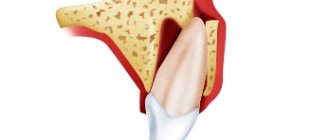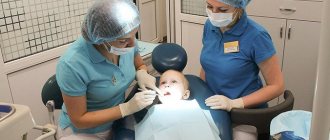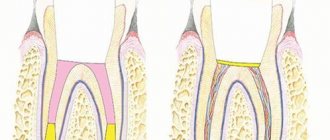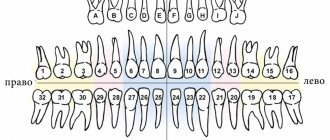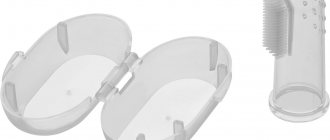Modern dental treatment
Dental treatment of teeth is a set of measures aimed at eliminating the inflammatory process and restoring chewing functions. The most common disease is, of course, caries and its complications. The timing of dental treatment directly depends on the stage of development of the disease. Thus, installing a dental crown or implanting several teeth will take different times, depending on the number of specialist appointments. It is worth noting that regular preventive examinations allow you to notice pathologies at an early stage, allowing for dental treatment without extraction and significantly simplifying it.
If a patient comes to the clinic with acute pain, the task becomes much more complicated. Therefore, every dentist will tell you that the best dental treatment is prevention.
Photos before and after dental treatment
Photos Before and After treatment of chewing teeth.
Photos Before and After treatment of front teeth.
What to do if an adult’s tooth crumbles?
If you notice that a tooth is crumbling, you should immediately run to the dentist. You cannot ignore the problem or self-medicate, this can only make the situation worse. Initially, the doctor conducts an examination, and then selects the appropriate treatment tactics.
In any case, the patient should remember the following points:
- oral hygiene. You should brush your teeth twice a day, you can rinse your mouth after eating, but you should not use toothpicks or other factors that can cause injury. The ideal option is to choose a paste and brush together with your dentist;
- nutrition. It is worth leaning more on foods that are healthy for your teeth. We are talking about eggs, legumes, fish, fruits, vegetables, hard cheese, dairy products;
- fight against bad habits. It is recommended to forget about alcohol, sweet chewing gum, and smoking.
Today, modern dentistry can offer several options that can heal teeth and prevent them from crumbling:
- Remineralization. The enamel is coated with a special solution consisting of calcium and fluorine. This method is relevant in the early stages, when the defects are even less significant. Can be used in children.
- Filling. Using this method, you can restore teeth when there is caries. The material allows you to completely restore the functionality of the teeth and their anatomical shape.
- Crowns. Here, a tooth that is destroyed is covered with an orthopedic structure. It looks like a healthy tooth. They are placed when most of the tooth is damaged and cannot be restored with filling material.
- Veneers. They are used when several teeth are destroyed and a cosmetic defect needs to be removed. Veneers are a very thin plate that can hermetically cover the front teeth and their surface.
- Prosthetics. This treatment option is already used if several teeth have decayed and other methods have not produced any results.
You should not delay treatment, because as a result, a person’s healthy teeth may be seriously damaged. You should go to the dentist at the first symptoms.
Endodontic dental treatment
What is endodontic dental treatment? This is a procedure aimed at treating root canals, usually using a microscope. If you ignore the symptoms of caries for a long time, pulpitis, periodontitis and other complications develop. Endodontic treatment of teeth under a microscope will help eliminate acute pain and relieve inflammation. The help of an endodontist is indispensable when there is a suspicion of a dental cyst or granuloma. Often, after canal treatment, complications arise due to poor quality treatment or stuck pieces of broken instruments. In such difficult cases, they also resort to endodontic treatment of the tooth canal under a microscope.
Treatment without drilling
Dental treatment without drilling involves the use of minimally invasive procedures. Some of them have been mentioned above. In particular, lasers are actively used to eliminate caries. This type of dental treatment is performed for adults and children. Among the main advantages is a reduced risk of any infection, since contact of equipment with organs and tissues of the oral cavity is eliminated.
Also, dental treatment without a drill can be performed using the chemical-mechanical method. A special preparation is applied to the area of the tooth affected by caries. It contains sodium hypochlorite and amino acids. Next, the specialist treats the affected area using special tools. Since only dead tissue is removed, the filling occupies a much smaller area, and it is also possible to preserve healthy areas as much as possible.
Another interesting technique was developed by German specialists. It is based on the bactericidal properties of ozone and is often used in pediatric dentistry. The gas used to treat teeth completely destroys microorganisms that cause caries.
The latest non-invasive methods
Before dental treatment, a specialist determines the degree of destruction of enamel, hard tooth tissue and dentin. In advanced cases, a granuloma forms around the root, which may subsequently increase in size. Modern methods of dental treatment make it possible to successfully combat the first signs of caries without the use of a drill. Among them:
- laser dental treatment;
- application of chemical-mechanical techniques;
- fluoridation – treatment of teeth with calcium;
- application of the air-kinetic method;
- ozone therapy.
Treatment of a tooth under a crown
After some time has passed after the installation of the prosthesis, subsidence of the gums and exposure of the neck of the tooth are often observed. All this contributes to the development of caries, and therefore pulpitis, periodontitis and other unpleasant diseases can appear even when the tooth is covered with a crown. Only a specialist can identify the problem and treat the tooth under the crown. If a disease is detected, the structure may need to be removed.
It is also the cause of problems - errors in the manufacture of the prosthesis: if the crown does not fit tightly around the neck of the tooth, bacteria can get under it. The specialist immediately removes such structures and carries out dental treatment. The crowns will subsequently be replaced, which will preserve the teeth and prevent the development of more serious diseases.
Anesthesia
Conventional local anesthesia is performed very often today. Patients with increased sensitivity of soft tissues and children can first be given topical anesthesia. Also in dentistry, painkillers are used for dental treatment. The type of drug and its dosage are selected individually - it all depends on both the patient’s health condition and the clinical situation. For example, pediatric dentists often treat teeth with nitrogen. Laughing gas causes a feeling of mild euphoria and is not hazardous to health. The patient relaxes, and the doctor can calmly perform all the necessary manipulations. But general anesthesia in dentistry is used only in the most extreme cases.
Anesthesia after dental treatment can last up to 3 – 4 hours. Everything here is very individual and depends on how much anesthetic was used.
Features of treatment of anterior teeth
Treatment of anterior teeth is associated with some difficulties. A characteristic feature of the incisors is their smaller size compared to other teeth. The work that a dentist has to do is truly jewelry. Only an experienced specialist can achieve a high degree of aesthetics.
In the process of treating and restoring the shape of a diseased tooth, a filling can be performed using light-curing polymer materials or veneers. Their shade is selected taking into account the color of the enamel of the patient’s healthy teeth.
The last resort is the installation of crowns. This method is justified only if the tooth is severely damaged. Treatment of lower teeth in the frontal zone is performed using similar methods and techniques.
What is a wisdom tooth and where is it located?
The name “wisdom tooth” is assigned to the third molar, the so-called figure eight, the eighth tooth in a row. The period of wisdom teeth eruption is approximately from 20 to 27 years. In rare cases, they appear after 40 years. It is precisely with the age of eruption that the name of eights—“wisdom teeth”—is associated, because in fact they appear in a person during the period of maximum maturity of the body.
It is interesting that in some people, despite the presence of the rudiments of teeth, they may not erupt throughout their lives. Scientists explain this fact by the fact that in the process of evolution, modern people's jaw has become shorter by about 12 mm compared to their ancestors, which is due to softer food, when chewing which there is no heavy load on the jaw.
If figure eights do erupt, they often cause pain and discomfort to the person. If the jaw is small, then in the process of growth the eights can shift the dentition, which leads to the curvature of other teeth. Therefore, many people try to remove them whenever possible. But the very fact of having a “wise” tooth is not always a reason for its removal.
Reason to see a doctor: symptoms that cannot be ignored
If a tooth hurts, treatment should never be delayed. Any delay is fraught with serious problems not only for the oral cavity, but also for the whole body. The sooner the source of infection is identified, the easier and faster dental treatment can be performed in the clinic. Symptoms that indicate serious problems:
- acute throbbing pain in the tooth;
- significant increase in sensitivity;
- bad breath during regular hygiene;
- bleeding and swelling of the gums;
- tooth mobility;
- difficulty opening the mouth;
- the appearance of a defect on a tooth, an area with uneven edges and pigmentation.
How are teeth arranged in teenagers?
A newly erupted and grown tooth needs several years to fully form: its roots are not yet narrow and long enough, and its walls are much thinner. This leads to the fact that the tooth is able to withstand a significantly lower degree of load than at an older age.
Pulp
(nerve) at this age is larger in size, while hard tissues - enamel and dentin - on the contrary, are more permeable, thin, and slightly mineralized. This means that teeth are more fragile and more susceptible to caries. Acids actively act on thin enamel and destroy it - carious processes become more active. The pulp is located close, which increases the risk of inflammation of the neurovascular bundle of the tooth (pulpitis). Treatment of an inflamed nerve is complicated by the fact that it is necessary not only to remove the inflamed tissue, but also to try not to damage the growth area of the tooth root. Otherwise, the root will not be able to grow, the tooth will remain unformed, and its “life” will decrease.
Fissures
(grooves on the chewing surfaces of teeth) at this age are deeper, they often have hidden cavities where bacterial plaque accumulates, which also leads to the rapid development of caries.
Teenagers under 18 years old should not have implants
. Therefore, tooth extraction should be a last resort when no other treatment is possible. Losing a tooth leads to displacement, malocclusion, deformation of the facial bones, and the appearance of gaps. In adolescents, these processes occur especially quickly. In addition, after a tooth is removed, the amount of bone tissue in its place decreases, so it will have to be restored before implantation.
Stages of dental treatment
Despite the fact that modern methods involve virtually painless dental treatment, fillings and other procedures, many patients appear in the doctor’s office with acute pain and a whole “bouquet” of oral diseases. Treatment usually includes the following steps:
Diagnostics
A specialist examines the oral cavity, identifies problems and draws up a treatment plan. Additional examinations may be ordered. At the same stage, the doctor conducting the consultation discusses the cost of services with the patient and selects the most convenient time for an appointment.
Professional oral hygiene
It is advisable to begin dental treatment only after their surface is cleaned of hard and soft deposits.
Treatment
The process of treating caries involves removing the affected tissue. The procedure is performed using local anesthesia, and the treated area is isolated from the rest of the mouth. Rubber dam or cotton swabs can be used for these purposes.
Seals
Filling is carried out after cleaning the carious cavity. The final procedure is grinding the filling - this is necessary to eliminate the occurrence of discomfort during the process of chewing food.
Causes of severe tooth decay in adults
Teeth in older people, children, women who are in menopause, pregnant women, and adults who have deficient nutrition are considered especially sensitive and prone to decay. Mineralization of teeth occurs under the influence of certain factors. And if there is a failure at any stage at which the crystal lattice is formed, then the bone is destroyed. The reasons why teeth crumble in adults include the following:
- Deficiency of microelements and vitamins in the human body. It is important to pay special attention if the amount of vitamin D, phosphorus, or calcium is too small. This may be related to that. That a person lives in an endemic area where there is not enough minerals in the water and soil. Poor nutrition may also be a cause.
- Violation of metabolic processes. If an adult has disorders in the endocrine system, diseases of the gastrointestinal tract, then a failure occurs in the process of absorption of nutrients. And even if a sufficient amount of minerals enters the body, it will still be deficient.
- Hormonal dysfunctions. Often especially fragile teeth are observed in women who have reached menopause. They have less female hormones. And some of them are responsible for bone density;
- Improper oral hygiene. Plaque will cause bacteria to multiply and tooth decay to form. The latter, in turn, contributes to the destruction of tooth tissue.
- Various malocclusions. If the jaw closure is impaired, then the teeth are regularly injured, the enamel becomes thinner and then crumbles;
- Unhealthy Lifestyle. Cigarettes, coffee, and alcohol are very harmful to teeth. Also, don’t get carried away with seeds.
Why does a tooth hurt after treatment and what to do in this case?
Aching pain after treatment occurs quite often. However, its causes may be different, which means that the doctor’s actions to eliminate it are required different. Let's look at the most popular:
- Very often, after treatment, the tooth reacts to mechanical stress when chewing food. As a rule, minor pain appears after treatment of deep caries. This is due to the fact that the filling puts pressure on the pulp. Over time, the pain will pass.
- It is not uncommon for a tooth to ache after treatment and due to an individual reaction to the doctor’s intervention. The pain may persist for several days.
- Acute pain after dental treatment cannot be ignored. You must immediately contact a specialist. Unpleasant pain may indicate that there is inflammation after dental treatment.
- If you are sensitive to irritants such as hot and cold drinks, sweet or sour foods, then there is a high probability that the overhanging edge of the filling will injure the periodontal tissue in the gum area. This phenomenon leads to tissue inflammation and exposure of the tooth root, which is extremely sensitive to any irritants. Therefore, be sure to contact the dental clinic if your tooth aches after recent manipulations. The treatment was most likely carried out poorly.
How much does dental treatment cost in Moscow?
Taking into account the fact that therapy involves an integrated approach, the total cost of dental services will consist of the costs of individual procedures. Approximate prices for dental treatment in Moscow are presented in the table below.
| Type of service | Price |
| Specialist consultation | from 500 rubles, but most often it is free |
| Professional hygiene of the entire oral cavity | from 3,000 rubles |
| Treatment of pulpitis (depending on the number of channels) | from 4,000 rubles |
| Filling using light-curing polymer material | from 3,000 rubles |
| Aesthetic restoration of anterior teeth | from 5,000 rubles |
How are teeth restored?
Indirect dental restoration is a more complex and time-consuming process that will require some time to produce veneers or lumineers. Veneers are thin plates that are applied to the surface of the enamel to create the patient’s ideal smile. If you put veneers on your teeth, they will eliminate various types of defects on your teeth, straighten your teeth and correct irregular tooth shapes.
Indirect dental restoration is carried out in several stages. The first stage includes complete dental sanitation. It is necessary to cure carious lesions and eliminate defective fillings. To install veneers, you will need to remove the top layer of enamel, which is considered a disadvantage of restoration with veneers, since after their installation, you will need to wear them all your life. The indirect method of restoring teeth involves taking an impression of the teeth and making them. Ask the question of restoration in a dental laboratory, then you need to isolate the tooth from moisture, dry the surface and fix the finished inlay with special cement. The method of restoration, direct or indirect, is determined by the doctor together with the patient, based on the objectives, the patient’s financial capabilities and the clinical picture.
Artistic restoration of anterior teeth is performed in cases where it is necessary to restore the aesthetics of the anterior or lateral teeth, problems such as decayed teeth, which crowns are best to put on chewing teeth, chipped teeth, interdental spaces are solved using the direct restoration method. It is important to understand the difference between direct and indirect Types of crown restoration of teeth. The direct method involves the implementation of restoration directly in the patient’s mouth using modern light-curing composite materials.
Direct restoration allows you to restore teeth with a removable denture in one visit to the doctor (up to 6 teeth). Thanks to the aesthetic properties of the materials used for direct restoration of anterior teeth, the patient's smile is completely transformed without the effect of artificial teeth. In the photo, it is impossible to determine whether implants were placed on the chewing teeth, the tooth being restored, since its tone and transparency completely correspond to the neighboring teeth. This effect is achieved using a special layer-by-layer technique. On the video on the Internet you can see how the restoration of the front teeth is carried out using the direct method.


